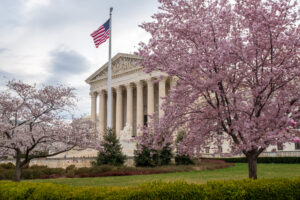If
there
is
a
single
“it”
conference
right
now
in
legal
tech,
it
is
the
TLTF
Summit.
Last
week
was
the
third
annual
occurrence
of
this
invite-only
event,
and
while
organizers
accepted
500
registrants
–
up
from
150
the
first
year
–
it
left
another
1,000
hopefuls
sitting
on
a
waiting
list.
I
guess
I
was
right
when,
after
the
first
year,
I
predicted
that
when
registrations
opened
for
the
second
year,
“it
will
likely
be
the
legal
tech
equivalent
of
a
Taylor
Swift
ticket.”
For
those
who
did
score
an
invite,
it
was
well
worth
their
time
–
and
not
just
for
the
opportunity
to
visit
Miami
in
December.
Every
attendee
that
I
had
the
chance
to
speak
to
described
this
event,
without
reservation,
as
the
best
legal
tech
conference
they’d
been
to.
Not
the
best
legal
tech
conference
this
year,
mind
you,
but
the
best
ever.
If
“renewal
rate”
is
any
indication,
consider
that
of
the
150
who
attended
the
first
year,
108
have
attended
each
subsequent
year.
(Me
among
them.)
Some
additional
number
of
those
first-year
attendees
have
attended
at
least
one
additional
year.
Legal
futurist
Richard
Susskind
was
featured
in
a
fireside
chat.
In
fact,
being
a
three-peat
was
a
badge
of
honor
at
the
conference
–
quite
literally
–
in
that
the
name
badges
showed
the
years
the
person
had
attended.
After
the
first
TLTF
Summit,
I
described
it
as
the
Davos
of
legal
tech,
in
that
it
brought
together
leaders
from
across
disciplines
to
engage
in
open
and
unfettered
dialogue
about
the
state
and
future
of
legal
innovation.
To
encourage
dialogue
(and
networking),
the
summit
operates
under
the
Chatham
House
Rule,
by
which
participants
are
free
to
use
the
information
they
receive,
but
not
reveal
the
identify
or
affiliation
of
any
speaker
or
participant.
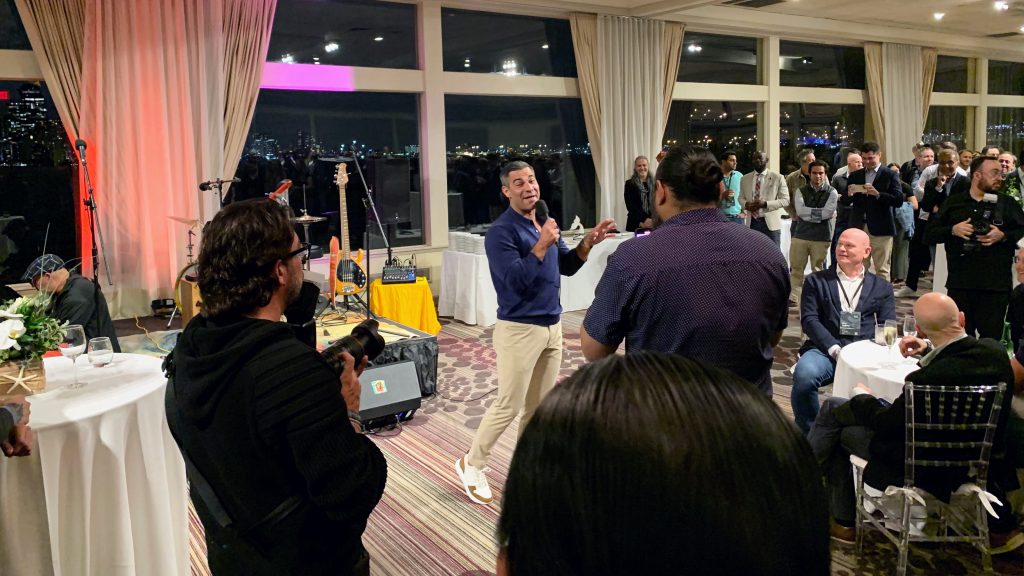
Miami
Mayor
Francis
Suarez
was
on
hand
to
welcome
attendees
to
the
opening
night
reception.
Also
helping
to
foster
dialogue
is
the
summit’s
intimacy.
With
just
150
participants
the
first
year
and
300
last
year,
some
worried
that
this
year’s
jump
to
500
would
stifle
that
sense
of
intimacy.
Thankfully,
it
did
not.
In
fact,
this
year’s
summit
was
everything
it
had
been
in
those
prior
two
years,
and
maybe
more.
Among
those
who
attended
for
the
first
time
this
year,
the
only
regret
I
heard
was
that
they
hadn’t
attended
the
prior
two.
Thought
Leaders
At
the
Forefront
By
way
of
background,
the
TLTF
Summit
is
produced
by
The
LegalTech
Fund,
the
first
venture
capital
firm
to
focus
exclusively
on
legal
tech.
The
goal
of
the
summit
is
to
bring
together
“the
most
innovative
thought-leaders
at
the
forefront
of
the
legal
industry.”
It
featured
three
days
of
programming
along
seven
tracks:
general,
law
firm,
ALSP,
GC/legal
ops,
compliance,
fintech
and
consumer.
There
were
16
panels,
seven
roundtables,
four
education
sessions,
and
four
fireside
chats.
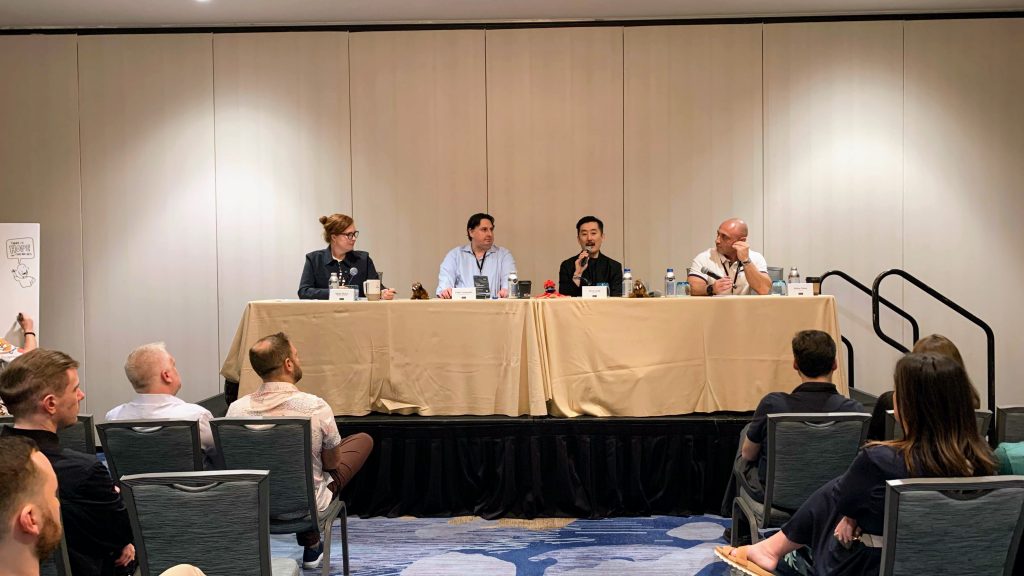
Discussing
how
legal
AI
startups
compete
against
AI
giants
were
Nikki
Shaver,
CEO
of
Legaltech
Hub;
Pablo
Arredondo,
vice
president,
CoCounsel,
Thomson
Reuters;
Steve
Gong,
corporate
counsel,
head
of
data
science
&
operations,
Google;
and
Julian
Tsisin,
director
legal
and
compliance
technology,
Meta.
Interspersed
through
the
three
days
was
the
Startup
Showcase,
where
pre-seed
through
Series
A
companies,
selected
by
a
panel
of
judges,
took
to
the
stage
and
presented
their
pitches.
Twenty-four
companies
presented,
out
of
200
applicants.
Five
were
selected
by
attendees
to
present
as
finalists
on
the
last
day
of
the
summit.
(The
five
that
attendees
voted
to
be
finalists
were:
Rasa,
Boltive,
Trustie,
Skribe
and
Neur.on.)
Engagement
and
Serendipity
If
you
have
read
this
far,
no
doubt
you
are
wondering
just
what
it
is
that
makes
this
conference
so
special.
As
someone
who
has
attended
more
than
my
fair
share
of
legal
tech
conferences
over
the
years,
I
have
come
to
understand
that
the
qualities
that
separate
a
great
conference
from
a
mediocre
or
poor
one
are
largely
intangible
and
therefore
difficult
to
define.
But
let
me
try.
Without
question,
the
defining
trait
of
this
summit
is
its
atmosphere
of
engagement,
discovery
and
serendipity.
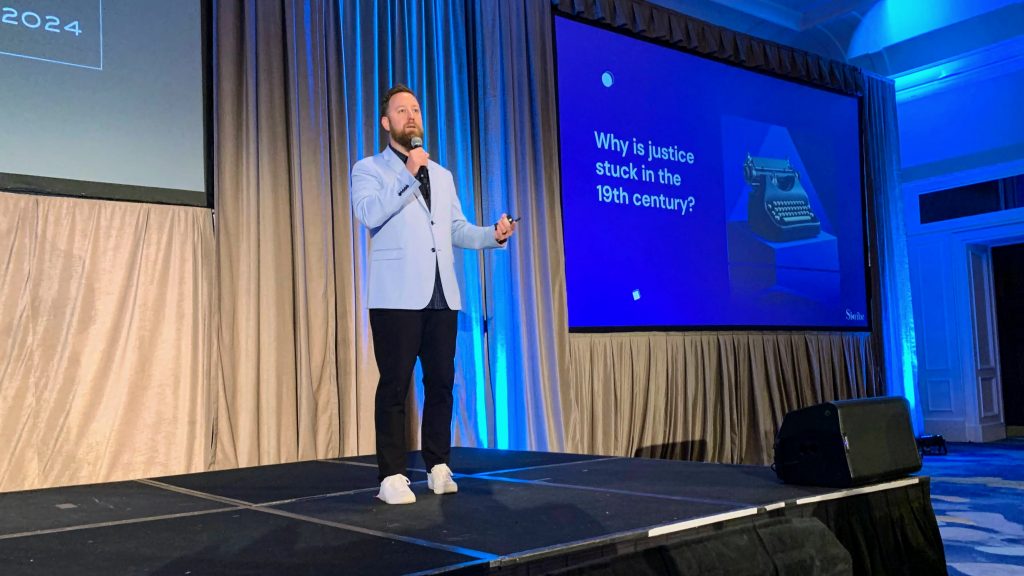
On
the
startup
showcase
stage,
Karl
Seelbach,
founder
of
Skribe.ai,
delivers
his
pitch.
At
the
opening
of
last
year’s
summit,
organizer Zach
Posner,
cofounder
and
managing
director
of
The
LegalTech
Fund,
urged
attendees
to
“skip
a
session,
skip
every
single
session,”
and
instead,
“Take
a
walk
with
somebody.”
Conjuring
a
concept conceived
by
business
author
Jim
Collins,
Posner
said,
“Our
goal
is
to
make
‘who
luck’
happen.”
I
do
not
know
whether
he
again
invoked
“who
luck”
this
year,
as
I
arrived
late
to
his
opening
keynote,
but
regardless,
it
was
available
in
abundance.
As
noted,
the
conference
operates
under
the
Chatham
House
Rule,
and
attendees
are
encouraged
to
talk
often
and
openly
with
one
another
–
even
better
if
the
talk
is
with
a
stranger.
To
underscore
this,
attendees
this
year
were
given
bingo
cards
with
which
they
could
win
prizes
by
identifying
people
who,
for
example,
owned
a
working
farm
or
had
been
in
legal
tech
since
the
1980s.
The
hallways
were
constantly
full
of
people
sitting
and
standing
in
pairs
or
groups,
engaged
in
animated
conversation,
and
a
large
room
was
set
up
as
an
all-day
coffee
shop
with
tables
and
even
live
music.
This
isn’t
networking
in
the
traditional
sense
of
exchanging
business
cards
and
elevator
pitches.
Instead,
it’s
an
intentional
cultivation
of
serendipitous
connections.
Unique
Mix
of
Participants
Of
course,
encouraging
conversation
would
be
fruitless
if
there
were
no
one
interesting
with
whom
to
converse.
After
the
conference
was
over,
one
participant
–
a
veteran
of
many
legal
tech
conferences
–
told
me
that
what
most
impressed
him
was
how
smart
the
attendees
were.
That
might
sound
pretentious,
but
it
is
probably
also
factually
accurate.
The
people
who
attend
this
conference
are
the
cream
of
the
crop
of
those
who
are
thinking
about
and
working
on
the
future
of
legal
practice
and
legal
technology.
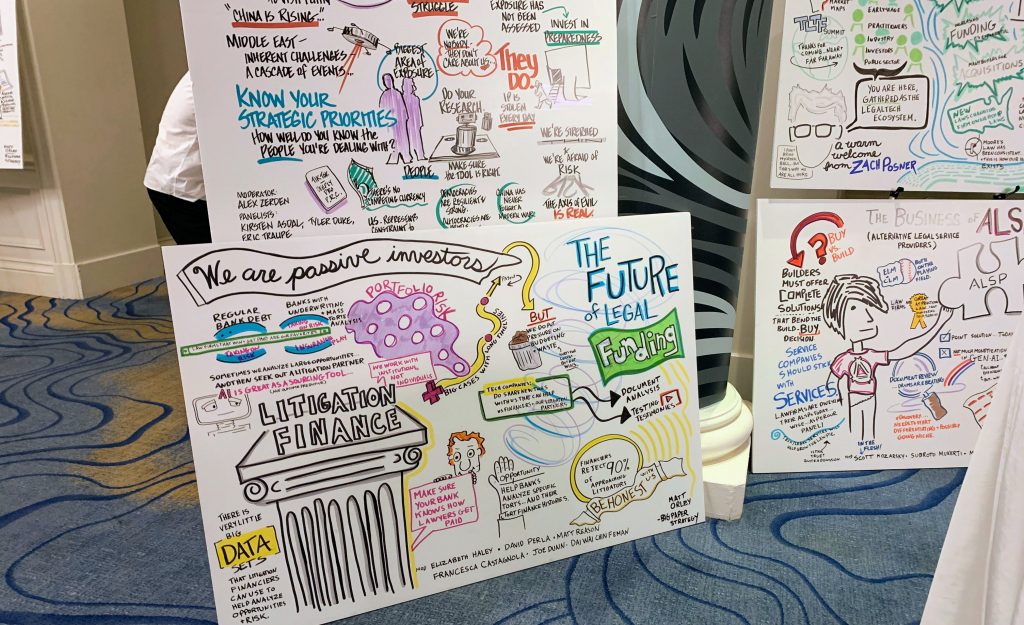
Cartoonists
captured
the
key
points
of
each
session.
Driving
that
is
the
summit’s
unique
mix
of
attendees.
The
summit
somehow
manages
to
draw
a
mix
of
people
unlike
what
I
see
at
any
other
legal
tech
conference.
There
are
veteran
founders
and
big-name
CEOs.
There
are
fledgling
startups
and
late-stage
enterprises.
There
are
law
firm
innovation
leaders
and
corporate
operations
professionals.
There
are
practicing
lawyers
and
legal
academics.
There
are
people
from
the
public
sector
and
people
from
“legal
tech
adjacent”
consultancies
and
service
providers.
Most
significantly,
at
least
to
my
mind,
there
are
investors
from
major
venture
capital
and
financial
firms,
who
are
open
and
active
participants.
This
is
unlike
at
other
conferences,
where,
if
they
attend
at
all,
they
tend
to
lurk
in
the
shadows,
prospecting
in
stealth
mode.
At
the
TLTF
Summit,
a
late-stage
enterprise
CEO
might
find
herself
in
deep
conversation
with
a
pre-seed
startup
founder.
A
criminal
defense
lawyer
could
be
discussing
artificial
intelligence
with
a
venture
capitalist.
Or
maybe
all
four
of
those
people
are
sitting
together
over
a
cocktail
in
the
balmy
twilight.
Sales-Free
Zone
In
virtually
every
conversation
I
had,
I
asked
people
what
they
thought
of
the
summit.
As
I
already
reported
above,
to
a
one
they
said
that
it
was
the
best
legal
tech
conference
they
had
attended.
Every
time
they
said
that,
my
next
question
was,
“Why?”
Two
answers
came
back
to
me
over
and
over
again.
One
was
what
I
have
already
described,
which
is
the
diverse
mix
of
attendees,
all
thought
leaders
in
their
respective
fields.
The
second
was
the
freedom
from
sales.
Remarkably
at
the
summit,
no
one
was
selling
anything.
There
were
no
exhibit
booths.
Elevators
did
not
blast
advertising.
Vendors’
branding
did
not
cover
every
surface.
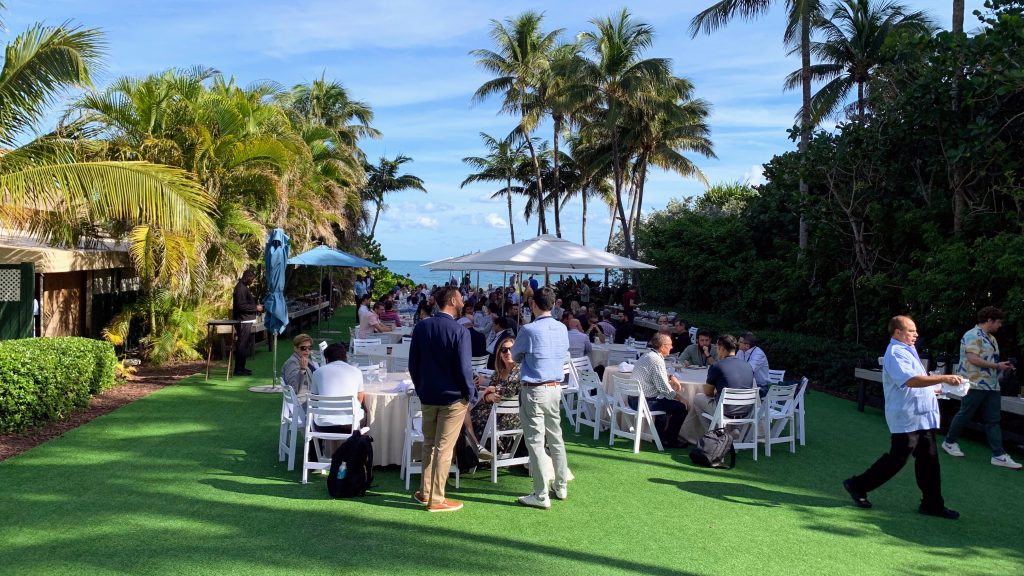
Meals
were
served
with
an
ocean
view.
From
what
I
heard,
this
was
liberating
for
both
vendors
and
others.
Of
the
people
I
spoke
to
who
work
for
legal
tech
companies,
most
of
whom
were
top
executives
of
those
companies,
their
shared
refrain
was
how
freeing
it
felt
to
be
at
a
conference
where
they
did
not
have
to
be
constantly
selling.
By
the
same
token,
the
lawyers
and
other
professionals
I
spoke
to
expressed
how
relieved
they
were
to
not
constantly
be
the
target
of
sales
pitches.
No
one
comes
to
the
summit
to
make
sales
(at
least
not
directly).
People
are
there
to
learn
and
share
and
collaborate
and
maybe
expand
their
perspectives
and
horizons.
And,
honestly,
that
simple
fact
created
an
air
of
lightness
at
the
summit
that
was
buoying.
But
Deals
Do
Get
Done
To
be
clear,
while
no
one
at
the
summit
was
there
to
sell
products,
there
were
deals
getting
done.
Investments
were
getting
discussed.
Acquisitions
were
getting
germinated.
Jobs
were
getting
offered.
Things
happen
at
this
conference,
make
no
mistake
about
that,
but
they
happen
discretely.
In
fact,
Posner,
in
his
keynote,
gave
some
numbers
about
deals
from
the
prior
years’
summits
–
at
least
the
deals
he
knows
of.
As
a
result
of
the
2022
and
2023
summits,
there
were:
-
18
rounds
of
funding.
-
3
M&A
events.
-
20
job
changes.
-
30
bizdev
relationships.
Only
time
will
tell
what
emerges
from
this
year.
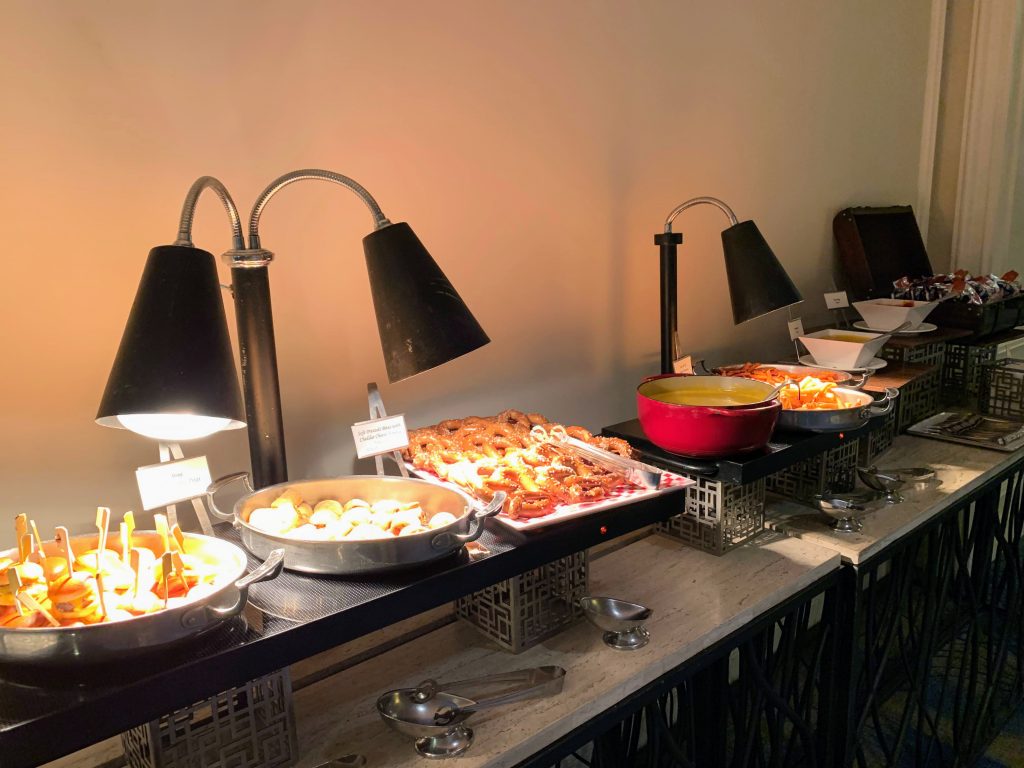
Between
meals,
snacks
were
abundant.
Other
Standout
Features
While
those
are
some
of
the
intangibles
that
make
this
summit
great,
there
were
also
a
number
of
tangible
factors:
-
Top-notch
programming
and
speakers.
Look,
for
the
reasons
I’ve
already
discussed,
if
you
never
went
to
a
single
panel
during
the
conference,
you
are
forgiven.
But
the
panels
provided
plenty
of
incentive
to
break
away
from
all
those
hallway
conversations
and
learn
from
experts.
Particularly
thought
provoking
were
the
four
fireside
chats
that
punctuated
the
summit,
featuring
conversations
with
U.S.
Sen.
John
Hickenlooper
(D-CO),
Carta
CEO
Henry
Ward,
criminal
defense
lawyers
Alan
Dershowitz
and
Alex
Spiro,
and
legal
futurist
Richard
Susskind.
-
Picture-perfect
venue.
Four
words:
Ritz
Carlton
Key
Biscayne.
Need
I
say
more?
-
Good
and
seemingly
limitless
food.
The
conference
served
breakfast,
lunch
and
dinner,
all
of
which
were
tasty
and
included
vegetarian
and
gluten-free
options.
In
between
meals
were
various
arrays
of
snacks
and
sweets.
Most
meals
could
be
taken
outside
or
inside,
and
the
second
day’s
breakfast
was
broken
up
by
interest
groups.
-
No
legal
tech
conference
does
swag
like
the
TLTF
Summit.
At
a
designated
hour,
it
threw
open
the
doors
to
a
swag
room
–
or
what
you
might
have
thought
was
a
gold
rush
–
as
an
onslaught
of
attendees
filled
swag
bags
with
hoodies
and
t-shirts
and
hats
and
socks
and
sandals
and
all
sorts
of
other
paraphernalia.
It
was
an
embarrassment
of
riches
that
to
some
seemed
over
the
top,
even
as
they
rifled
around
for
a
size
L
hoodie.
Did
I
Just
Say
‘Chill’?
On
the
last
day
of
the
conference,
several
people
asked
me
what
my
big
takeaway
was
or
what
I
saw
as
the
big
theme.
Sure,
everyone
was
talking
about
gen
AI,
just
as
they
do
at
every
other
conference.
But
that
wasn’t
the
takeaway.
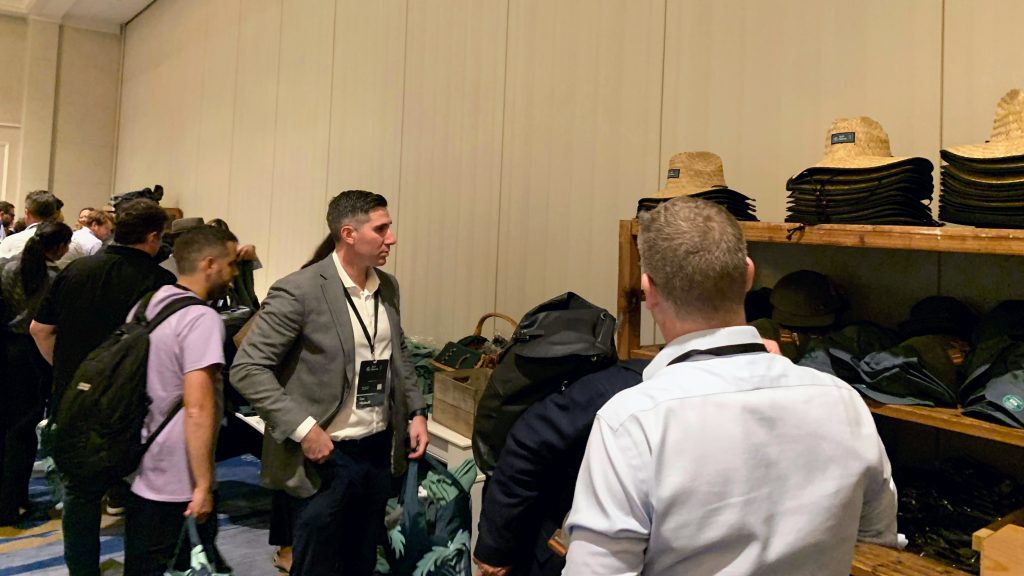
The
swag
room
was
an
embarrassment
of
riches.
If
I
haven’t
by
now
already
made
it
clear,
for
me,
the
theme
was
the
value
of
networking,
and
of
networking
beyond
your
comfort
zone
–
of
letting
serendipity
happen,
“who
luck”
happen.
I
met
so
many
new
people
this
week,
and
so
many
of
the
conversations
I
had
with
those
people
were
not
just
conference
chitter-chatter,
but
substantive
and
thoughtful
and
even
challenging
interactions.
A
unique
feature
of
this
conference
over
others
I’ve
attended
was
that
everyone
seemed
to
feel
free
and
relaxed
and
unburdened
and
open.
No
one
was
too
big
or
important
to
approach,
or
too
unapproachable
because
they
were
surrounded
by
their
people.
Everyone
was
on
equal
footing,
and
everyone
engaged
as
co-equal
peers.
People
often
refer
to
conferences
as
“shows,”
and
maybe
that
is
partly
because
we
are
all
expected
to
perform
when
we
attend
them,
to
be
“on”
and
play
our
designated
role.
Here,
the
pretense
seemed
to
melt
away.
I
found
myself
several
times
describing
the
conference
as
“chill”
–
which
is,
trust
me,
not
a
word
I
often
use,
and
certainly
not
to
describe
a
legal
tech
conference.
People
seemed
to
relax
and
let
down
their
guards
and
thereby
open
themselves
to
truly
engaging
with
one
another.
I
am
leaving
the
TLTF
Summit
energized,
enthusiastic,
and
grateful
for
all
the
“who
luck”
that
happened
for
me
there.
And,
of
course,
I
am
already
looking
forward
to
next
year’s
summit
–
provided
I
can
score
one
of
those
coveted
invites.
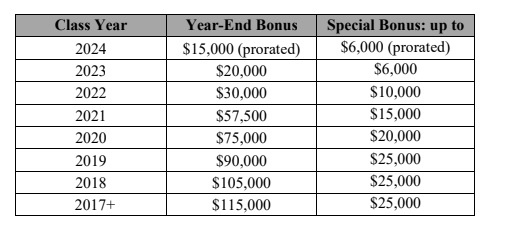
 Staci
Staci






